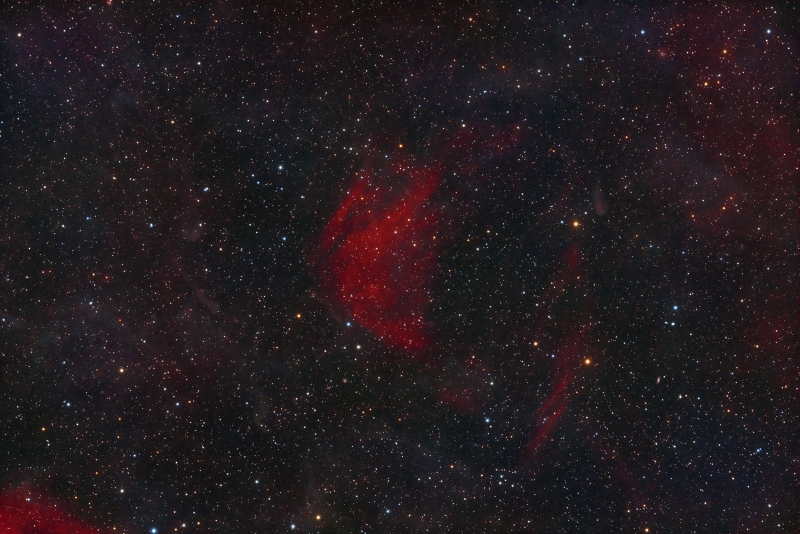Patchick-Strottner-Drechsler 6 (PaStDr6)
Published 4 Feb 22
Click on the image above for full resolution
About this object
The above image is the first deep image ever taken targeting Patchick-Strottner-Drechsler 6 (PaStDr6). PaStDr6 is a very faint candidate planetary nebula in the constellation Perseus first discovered by Dana Patchick in April 2020 and independently by Xavier Strottner and Marcel Drechsler in August of 2020. It also goes by the designation PN G148.4-09.1. It's a very faint object not very far from the Planetary nebula HDW-3, parts of it which can be seen in the lower left corner of the image. PaStDr6 is very faint and required 20hrs of exposures through a 5nm Ha filter to show it without a great deal of noise. I also took a bit over 12hrs of OIII and the object contains very little to no OIII emission unlike most planetary nebula. It's possible it may be structure where the interstellar medium is ionized by an extremely hot white dwarf star. The candidate star is blue and can be seen by clicking on the image and looking at the full res image. Just to the right of the central part of the nebula is the potential white dwarf. Future studies will hopefully reveal the true nature of this object. PaStDr6 can be found at RA 03 22 38.97 and DEC +46 04 33.74
Also within the field of view are a good amount of faint background galaxies and molecular dust. The dust is faint but can be seen within the image. See the annotated image to see where these galaxies are.
The image is a Ha RGB composite. 20hrs of Ha exposures and 8.4 hrs of RGB exposures were taken. Image resolution is 1.28 arcsec/pixel.
The above image is the first deep image ever taken targeting Patchick-Strottner-Drechsler 6 (PaStDr6). PaStDr6 is a very faint candidate planetary nebula in the constellation Perseus first discovered by Dana Patchick in April 2020 and independently by Xavier Strottner and Marcel Drechsler in August of 2020. It also goes by the designation PN G148.4-09.1. It's a very faint object not very far from the Planetary nebula HDW-3, parts of it which can be seen in the lower left corner of the image. PaStDr6 is very faint and required 20hrs of exposures through a 5nm Ha filter to show it without a great deal of noise. I also took a bit over 12hrs of OIII and the object contains very little to no OIII emission unlike most planetary nebula. It's possible it may be structure where the interstellar medium is ionized by an extremely hot white dwarf star. The candidate star is blue and can be seen by clicking on the image and looking at the full res image. Just to the right of the central part of the nebula is the potential white dwarf. Future studies will hopefully reveal the true nature of this object. PaStDr6 can be found at RA 03 22 38.97 and DEC +46 04 33.74
Also within the field of view are a good amount of faint background galaxies and molecular dust. The dust is faint but can be seen within the image. See the annotated image to see where these galaxies are.
The image is a Ha RGB composite. 20hrs of Ha exposures and 8.4 hrs of RGB exposures were taken. Image resolution is 1.28 arcsec/pixel.
Image Details
- Optics : Stellarvue SVX 152T refractor @f8 1200mm FL
- Mount: Paramount MYT
- Camera: ZWO ASI6200MM Pro
- Filters: Chroma 50mm RGB, Astrodon 50mm 5nm Ha
- Exposure (min): HaRGB 1200:175:160:170, 28.4 hrs, 2x2 binning, 1.28"/pix
- Automation Control: The Sky X, Voyager, PrimaluceLab Eagle 4
- Guiding: StarlightXpress Lodestar X2
- Processing Software: PixInsight
- Location: Stark Bayou Observatory, Ocean Springs, MS
- Sky: Typical SQM 19.6, Bortle 5, Suburban
- Date: 1 Dec 21- 24 Jan 22







